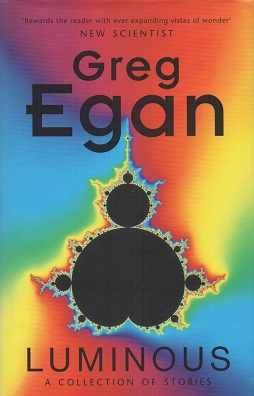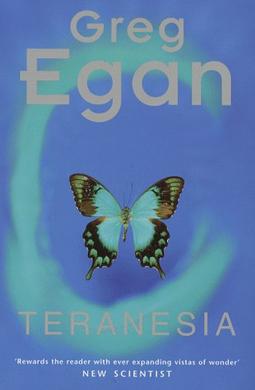Related Research Articles
Greg Egan is an Australian science fiction writer and mathematician, best known for his works of hard science fiction. Egan has won multiple awards including the John W. Campbell Memorial Award, the Hugo Award, and the Locus Award.
In human genetics, the Mitochondrial Eve is the matrilineal most recent common ancestor (MRCA) of all living humans. In other words, she is defined as the most recent woman from whom all living humans descend in an unbroken line purely through their mothers and through the mothers of those mothers, back until all lines converge on one woman.

In human genetics, the Y-chromosomal most recent common ancestor is the patrilineal most recent common ancestor (MRCA) from whom all currently living humans are descended. He is the most recent male from whom all living humans are descended through an unbroken line of their male ancestors. The term Y-MRCA reflects the fact that the Y chromosomes of all currently living human males are directly derived from the Y chromosome of this remote ancestor. The analogous concept of the matrilineal most recent common ancestor is known as "Mitochondrial Eve", the most recent woman from whom all living humans are descended matrilineally. As with "Mitochondrial Eve", the title of "Y-chromosomal Adam" is not permanently fixed to a single individual, but can advance over the course of human history as paternal lineages become extinct.

Luminous is a collection of short science fiction stories by Greg Egan first published in 1998 by Millenium.

Teranesia is a 1999 science fiction novel by Greg Egan. The novel follows protagonist Prabir Suresh, who lives on an island in the South Moluccas with his biologist parents, who are investigating the unique evolutionary traits of butterflies on the island. As civil war erupts in Indonesia, Prabir and his baby sister Madhusree must escape the islands. When they grow up, Madhusree becomes a biology student, motivated to carry on her parents' legacy in uncovering the evolutionary phenomenon. Prabir reluctantly follows her, as he must navigate and confront the truth that shaped his past.
In biology and genetic genealogy, the most recent common ancestor (MRCA), also known as the last common ancestor (LCA), of a set of organisms is the most recent individual from which all the organisms of the set are descended. The term is also used in reference to the ancestry of groups of genes (haplotypes) rather than organisms.
The Seven Daughters of Eve is a 2001 semi-fictional book by Bryan Sykes that presents the science of human origin in Africa and their dispersion to a general audience. Sykes explains the principles of genetics and human evolution, the particularities of mitochondrial DNA, and analyses of ancient DNA to genetically link modern humans to prehistoric ancestors.
"The Hundred Light-Year Diary" is a science-fiction short story by Australian writer Greg Egan, first published in Interzone 55 in January 1992. It was later published in the short story collection Axiomatic. It was a finalist for the 2007 Premio Ignotus for Best Foreign Story.
The Arrows of Time is a hard science-fiction novel by Australian author Greg Egan and the third part of the Orthogonal trilogy. The novel was published by Gollancz on 21 November 2013 with a cover art by Greg Egan and by Night Shade Books on 5 August 2014 with a cover art by Cody Tilson. The novel describes the return journey of the generation ship Peerless, which has been launched in The Clockwork Rocket and traveled into the void in The Eternal Flame, and the reverse enabling the construction of a device to receive messages from the own future as well as the journey to a world where time runs in reverse. The universe of the novel is therefore based on a Riemannian instead of a Lorentzian manifold, changing the rules of physics. The details are described by Greg Egan on his website.
"Axiomatic" is a science-fiction short story by Australian writer Greg Egan, first published in Interzone 41 in November 1990. The short story was included in the collection The Best of Greg Egan in 2020.
"Singleton" is a science-fiction short story by Australian writer Greg Egan, first published in Interzone 176 in February 2002. The short story was included in the collections Crystal Nights and Other Stories and Oceanic in 2009, as well as The Best of Greg Egan in 2020. The short story is set in the same universe as Egan's short story "Oracle" and Egan's novel Schild's Ladder.
Dark Integers and Other Stories is a collection of five science-fiction short stories by Australian writer Greg Egan, published in 2008 by Subterranean Press. One of them, "Oceanic", won the Hugo Award for Best Novella, while two others were nominated.
"Luminous" is a science-fiction short story by Australian writer Greg Egan, first published in Asimov’s Science Fiction in September 1995.
"Dark Integers" is a science-fiction short story by Australian writer Greg Egan, first published in Asimov's Science Fiction in October/November 2007. The short story was included in the collections Dark Integers and Other Stories in 2008, Oceanic in 2009 and The Best of Greg Egan in 2020. It was nominated for the Hugo Award for Best Novelette in 2008. It is a sequel to the short story "Luminous".
"Reasons to Be Cheerful" is a science-fiction short story by Australian writer Greg Egan, first published in Interzone 118 in April of 1997. The short story was included in the collections Luminous in 1998 and The Best of Greg Egan in 2020.
"Crystal Nights" is a science-fiction short story by Australian writer Greg Egan, first published in Interzone 215 in April 2008.
"The Cutie" is a science-fiction short story by Australian writer Greg Egan, first published in Interzone #29 in May/June 1989. It was his first to be published in Interzone. The short story was included in the collection Axiomatic in 1995. It also appeared in the anthology Interzone: The 4th Anthology edited by John Clute, David Pringle and Simon Ounsley in 1989.
"Appropriate Love" is a science-fiction short story by Australian writer Greg Egan, first published in Interzone #50 in August 1991. The short story was included in the collection Axiomatic in 1995 and The Best of Greg Egan in 2019.
"Learning to Be Me" is a science-fiction short story by Australian writer Greg Egan, first published in Interzone 37 in July of 1990. The short story was included in the collections Axiomatic in 1995 and The Best of Greg Egan in 2019.
"Chaff" is a science-fiction novelette by Australian writer Greg Egan, first published in Interzone #78 in December 1993. The novelette was included in the anthology The Year’s Best Science Fiction: Eleventh Annual Collection edited by Gardner Dozois in 1994 and in the collections Our Lady of Chernobyl in 1995, Luminous in 1998 and The Best of Greg Egan in 2019.
References
- 1 2 "Bibliography". 2024-04-09. Retrieved 2024-04-17.
- ↑ "Summary Bibliography: Greg Egan" . Retrieved 2024-04-19.
- ↑ "חוה המיטוכונדרית" . Retrieved 2024-07-26.
- ↑ "星雲賞受賞作・参考候補作一覧" (in Japanese). Retrieved 2024-04-09.
- ↑ "Greg Egan Awards Summary". 2023-10-15. Retrieved 2024-04-09.